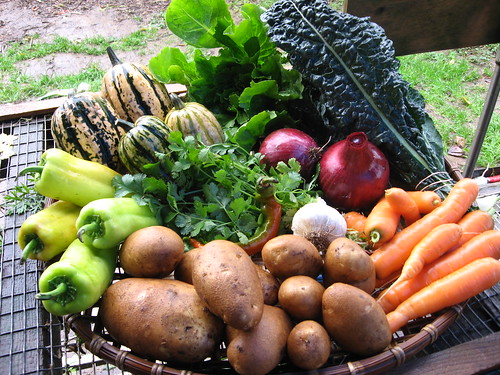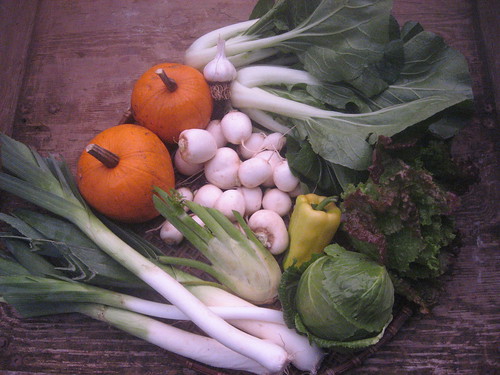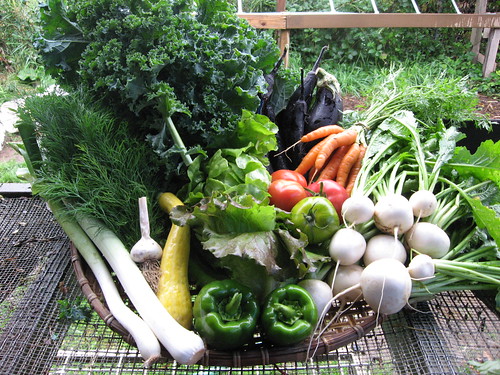This Week’s Share
- Beets
- Braising Mix
- Collard Greens
- Garlic
- Onion, Copra
- Parsnips
- Turnips, Hakurei
- Winter Squash, Acorn
As the rain establishes its presence and the coming of the winter season the farm crew has been busy making sure the bounty continues for the last four weeks of the CSA. This week’s share includes three new arrivals and several delicious repeat appearances. In your share you might at first be overwhelmed by the amount of greens, but have no fear both the braising mix and collard greens cook down to a more manageable sizes (1 lb. fresh = approx. 1 cup cooked). The braising mix is a beautiful blend of mustard greens and Asian greens and the Hakurei turnips compliment the mix well in a stir-fry.
Recipes
Collard Recipes
Collard greens can be used similarly to both chard and kale, and substituting them freely in recipes is appropriate.
Collard Green Olive Pesto
Adapted from Gourment and UCSC Farm and Garden CSA Field Notes
This recipe makes a large quantity of pesto. Use half the pesto for 1 pound of cooked pasta and chill the rest in an airtight container for up to 3 days (or freeze for up to 6 months).
10 leaves collard greens
7 large brine-cured green olives (2 ¼ oz.), pitted
2 garlic cloves, chopped
1/3 cup water
½ teaspoon balsamic vinegar
½ teaspoon salt
¼ teaspoon black pepper
½ cup extra-virgin olive oil
1 oz. finely grated Parmigiano-Reggiano
Bring a 6- to 8-quart pot of salted water to a boil. Meanwhile, cut stems and center ribs from collard greens and discard. Stir collards into water in batches, then simmer, uncovered, stirring occasionally until tender, about 15 minutes. Transfer collards with tongs to a colander and drain, gently pressing on greens to extract excess water. (If making pasta, reserve water in pot for cooking pasta.) Coarsely chop collards. Blend olives and garlic in a food processor (or blender) until finely chopped. Add collards, water, vinegar, salt, cayenne, and pepper and pulse until finely chopped. With processor running, pour in oil slowly until evenly blended. Turn off processor, then add cheese and pulse to combine.
Sautéed Collard Greens
From Jim Leap, Farm Manager at UCSC Farm and Garden
10 leaves fresh collard green
2 tablespoons olive oil
½ teaspoon hot pepper oil (a few drops)
½ teaspoon sesame oil (a few drops)
Garlic, chopped (choose amount according to your own preference)
Dash of salt or soy sauce
Sesame seeds
1-2 teaspoons water
Prepare collard greens by removing lower portion of the stem. Carefully stack and roll up the leaves and cut into ½ inch strips. In a cast iron frying pan or wok heat up the olive oil on medium-high (hot enough to lightly brown, but not burn garlic). Add the chopped garlic to the oil, and add the hot pepper oil and sesame oil as well. Quickly sauté the garlic until lightly browned. Throw in the collard greens and under fairly high heat toss to uniformly heat and mix. While sautéing greens add a dash of salt or soy sauce and toss in sesame seeds. Uniformly mix, lower heat, add water, and cover and steam for 5 minutes. May be eaten alone our served as a side dish, either way it is delicious.
Parsnip Recipes
If you are not familiar with parsnips prepare to enjoy yourself. Their sweet and nutty flavor lends well to a variety of dishes, and we have two recipes to start you off.
Maple Glazed Parsnips
Adapted from Simply in Season by Mary Beth Lind and Cathleen Hockman-Wert
This a great recipe for introducing parsnips to children or other skeptical tastebuds!
2 cups parsnips, peeled, cut in ½ rounds (about 1 ½ large parsnips or 2 medium parsnips)
1 tablespoon maple syrup
½ teaspoon butter, melted
2 tablespoons walnuts, chopped and toasted
Combine maple syrup and butter and pour over the cooked parsnips. Top with walnuts and serve.
Whipped Parsnips and Potatoes
Adapted from Fresh from the Farmers Market by Janet Fletcher
2 parsnips (1 lb.)
¾ lb. baking potatoes (Cannella’s from last weeks share work great)
½ cup heavy cream
1 clove garlic, minced
¼ onion, minced
2 tablespoons unsalted butter
salt (season to taste)
freshly ground black pepper (season to taste)
Peel parsnips and potatoes and cut into ½ inch chunks. Bring a large pot of salted water to a boil over high heat. Add parsnips and potatoes and cook until tender, 8 to 10 minutes. While vegetables are boiling, combine cream, garlic and onions in a small saucepan and bring to a simmer; simmer 1 minute, then adjust heat to keep warm without simmering.
Drain parsnips and potatoes. Either mash the vegetables with a potato masher or pass them through a food mill. This can be done directly in the pot. With a wooden spoon, beat in butter and warm cream mixture. Season well with salt and pepper. Serve immediately.
Braising Mix Recipe
The braising mix is a beautiful blend of mustard greens and Asian greens and the Hakurei turnips compliment the mix well in a stir-fry.
Quick and Tasty Young Winter Greens
Adapted from Field of Greens by Annie Somerville
2 pounds braising mix (in your share this week)
1-2 tablespoons olive oil
2 cloves garlic, minced (more if you desire)
2 quarter-size slices fresh ginger, peeled and cut into matchstick size pieces (about 2 tablespoons)
1 tablespoon soy sauce
Heat olive oil to medium-high heat in a large sauté pan or cast iron skillet. Add the garlic and ginger and sauté for 1 minute. Add the braising mix in portions until evenly combined and sauté for another 2-3 minutes. Add the soy sauce and continue to sauté for another minute. Greens should be wilted, but still crunchy toward the stem bases. Serve immediately.
Sauvie Island Organics is Growing
As the bounty for this season continues we are already planning for 2009. We will be expanding our CSA program from 250 members strong to 400 members. We will be adding an additional CSA pick up night and are hoping to venture into SW Portland. We will let you know when we decide on a site (we are open to suggestions). To make sure we continue to serve you to the best of our ability we have added a new year-round position to the Sauvie Island Organics’ crew. Below meet Francesca SIO’s new CSA Assistant.
We hope to continue growing for you in 2009. Please take a moment to fill out our 2009 Community Farm Agreement. Filling out this form and sending in your $100 deposit will ensure you a spot for 2009.
A New Face Joins the Sauvie Island Organics Crew

Hello CSA Members! My name is Francesca and I am the newest addition to the wonderful crew out at Sauvie Island Organics. I had the chance to meet many of you last week at your pick-up sites, and look forward to getting to know all of you through the end of this season and all of next season as the CSA Assistant. I moved to Oregon in June, and before making my way to Sauvie Island I was working as a youth educator at Zenger Farm in outer Southeast Portland. I recently completed my undergraduate degree in Environmental Studies at University of California, Santa Cruz and focused in agroecology and sustainable food systems. Although I am not a native Oregonian, I grew up in Spokane, WA and feel a strong connection with the Pacific Northwest. During and after my time in California I felt strongly about returning to the Pacific Northwest and found Portland the perfect place to set my roots and flourish. My large Italian family in Seattle, Tacoma, and Spokane are also excited to have me back within their grasp, and I owe the ability to follow my dreams to their unending love and support. Again, I look forward to working with all of you and thank you for your warm welcome to Portland and Sauvie Island Organics.










 In addition to our weekly CSA harvest, we have been busy harvesting our storage onions. These are the onions that some of you joined us in planting back in late April. Now, over four months later, the onions have formed bulbs and the tops have started to dry indicating that they are reaching maturity. Storage onions require ideal curing conditions. When onions “cure” the leaves dry and shrivel and ultimately create a seal so that disease doesn’t make its way into the succulent onion. Ideal conditions for curing are temperatures in the 75-85 degree range and humidity at 65-70%. Once the skins and tops are dry, we’ll clip the tops off, clean the onions, and then bring them your way over the months to come.
In addition to our weekly CSA harvest, we have been busy harvesting our storage onions. These are the onions that some of you joined us in planting back in late April. Now, over four months later, the onions have formed bulbs and the tops have started to dry indicating that they are reaching maturity. Storage onions require ideal curing conditions. When onions “cure” the leaves dry and shrivel and ultimately create a seal so that disease doesn’t make its way into the succulent onion. Ideal conditions for curing are temperatures in the 75-85 degree range and humidity at 65-70%. Once the skins and tops are dry, we’ll clip the tops off, clean the onions, and then bring them your way over the months to come.